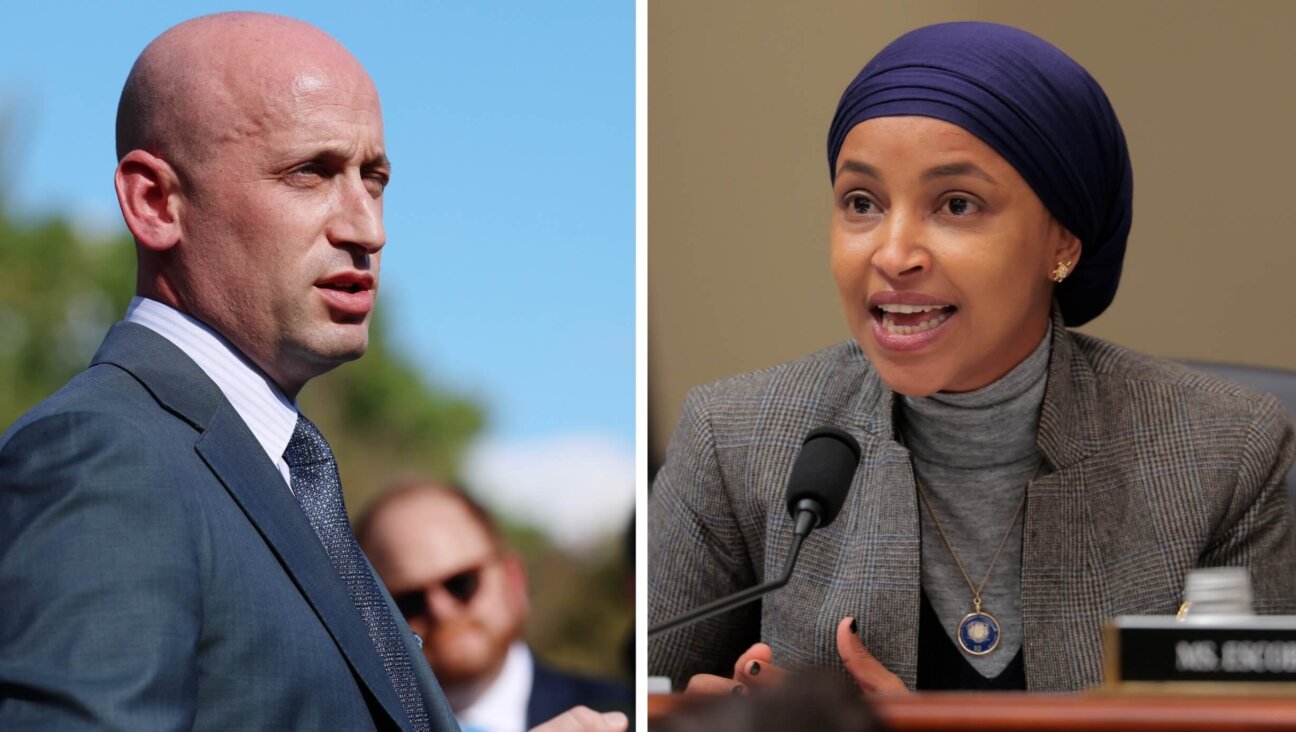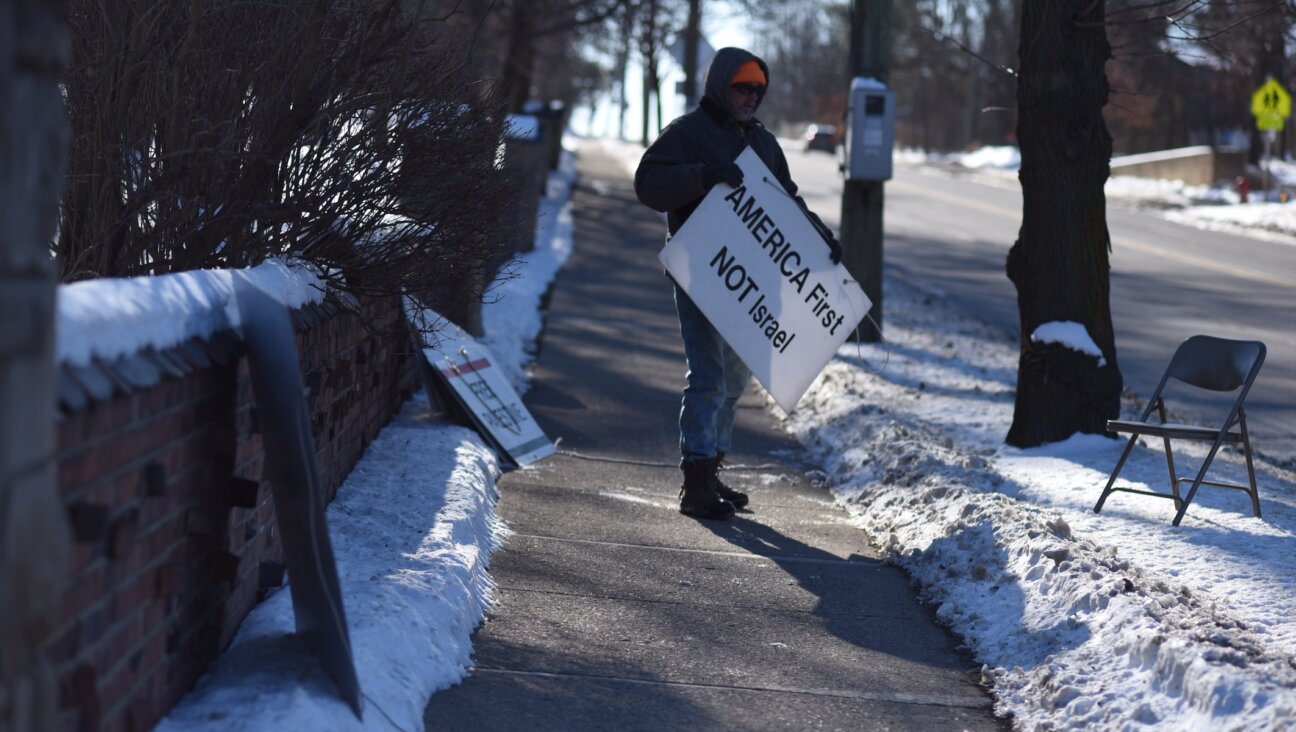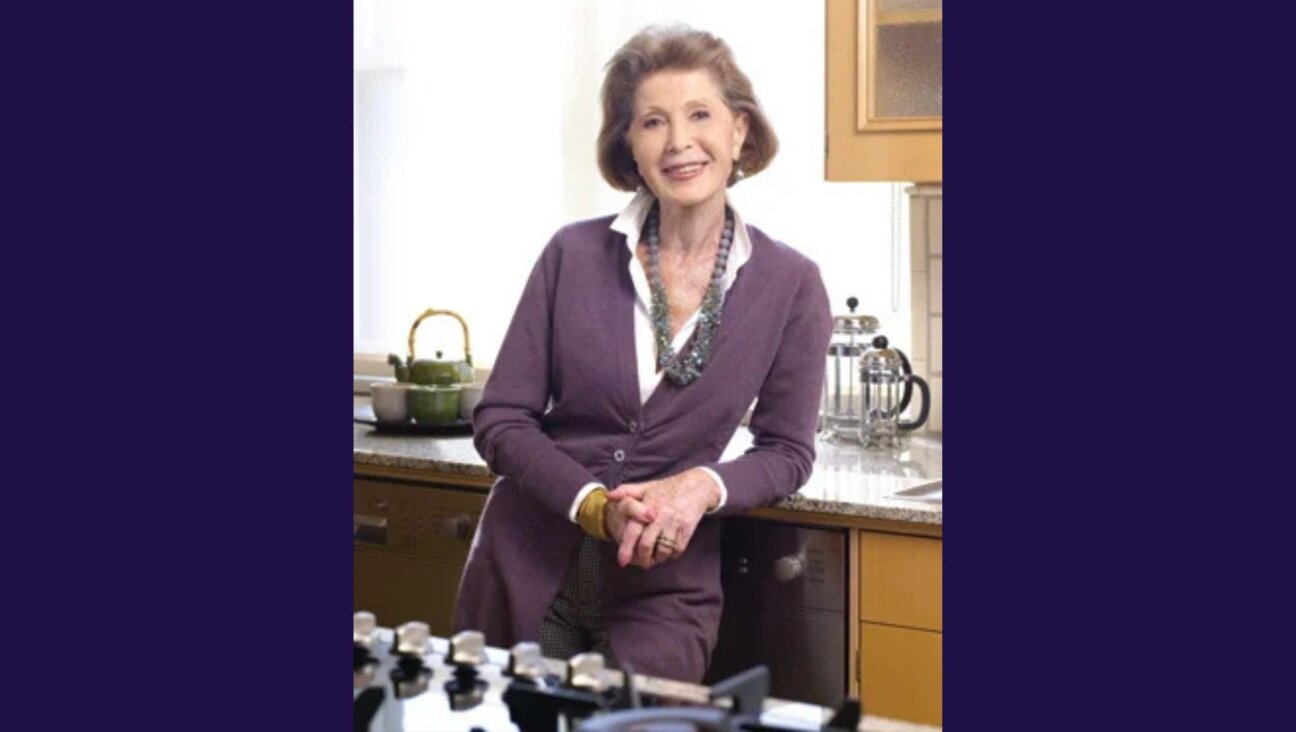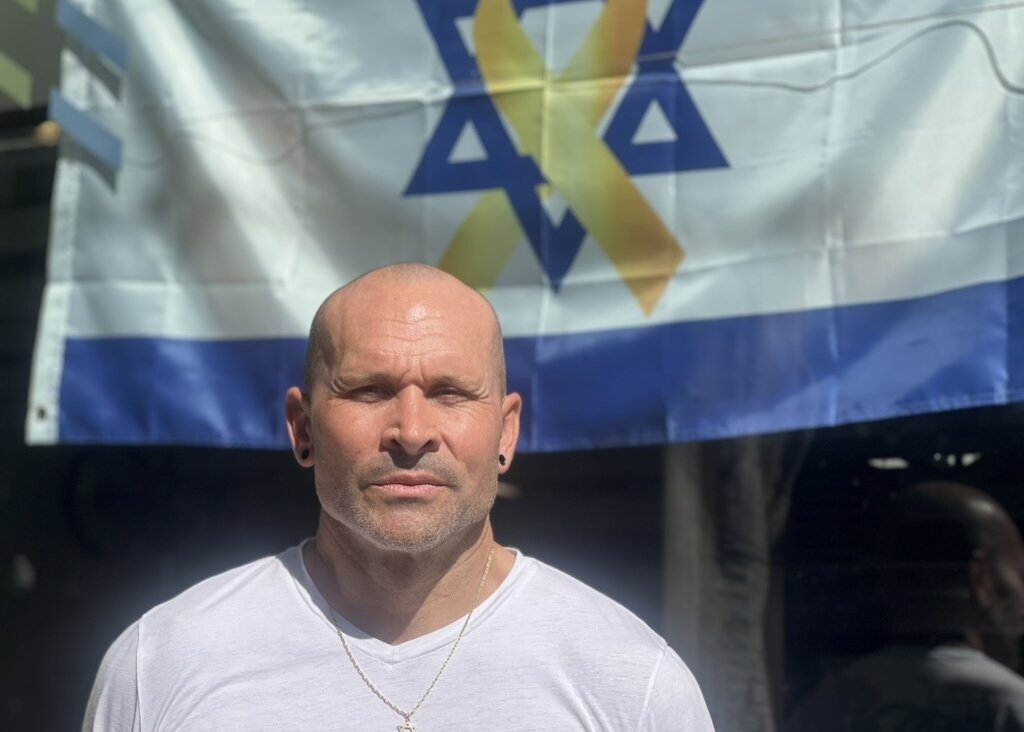Rabbi Ovadia Yosef, Sephardic Kingmaker of Israeli Politics, Dies at 93

Sephardic Legend Rabbi Ovadia Yosef, right, was revered for raising the profile of Sephardic Jews worldwide. Image by getty images
Ovadia Yosef, the rabbi responsible for turning religiously observant Sephardic Jews from a marginalized minority into one of Israel’s most politically powerful groups, has died at age 93.
Yosef was widely revered as a kind of living saint during his lifetime. He inspired adoring love songs extolling his virtues, and his death is expected to further cement his iconic status in the ultra-Orthodox Sephardic community which he led.
But Yosef is being mourned far beyond the ultra-Orthodox sector, thanks to enormous emphasis he placed on religious outreach in a way that Israel had never seen before. In terms of courting the non-Orthodox, he was the closest that Israel had to the late New York-based outreach pioneer, Menachem Mendel Schneerson, the Lubavitcher Rebbe.
There is one other similarity between Yosef and Schneerson. Both left, upon their death, a massive power vacuum in their movements and uncertainty among followers about whether or how it could be filled. For Yosef the movement in question was Shas, the political party he established in 1984, with its network of associated welfare and educational institutions. The often-used description of Yosef as Shas’ spiritual leader is an understatement — the movement is, from top to bottom, an expression of his religious outlook and political ethos. The party’s political leaders consulted Yosef — who never sat in Knesset — on virtually every decision they made.
And so, from his home in Jerusalem’s modest Har Nof neighborhood, where he lived surrounded by thousands of volumes of religious law and lore, he cast an enormous influence over the agenda of every Israeli government for nearly three decades. For much of its existence, his party and its demands held the key to whether governments survived or fell.
Ovadia Yosef was born in Baghdad on September 23, 1920, and immigrated to Jerusalem as a young child. He received a Haredi, or ultra-Orthodox, education, most notably at the newly founded Porat Yosef Sephardic yeshiva. Regarded by his teachers as a brilliant student, he was ordained a rabbi at 20.
In 1948 the Sephardic chief rabbi of then-British-ruled Palestine, Ben-Zion Uziel, appointed Yosef deputy chief rabbi of Cairo and head of that city’s rabbinical court, posts he filled for two years. He then returned to Jerusalem, where he studied in a kolel, or full-time Talmud program for adults.
He also authored treatises on Jewish law including a much-acclaimed book on Passover, and served in several rabbinical posts. These included stints as judge on the Jerusalem rabbinical court, judge on the Supreme Rabbinical Court of Appeals, and Sephardic chief rabbi of Tel Aviv. In 1970 he won the Israel Prize for rabbinic literature.
In 1973, after five years in the Tel Aviv post, Yosef became Sephardic chief rabbi of Israel. The nation had had only two Sephardic chief rabbis since independence, and the Ashkenazic establishment was not quite ready for the assertive, larger-than-life Yosef. He showed a marked preference for lenient rulings over strict ones, believing that Ashkenazic rabbis leaned too heavily toward ritual stringency, and fought hard to increase the public influence of Sephardic interpretations of rabbinic law over the dominant Ashkenazic interpretations.
Yosef maintained his preference for ritual leniency throughout his life. Unlike his Ashkenazi counterparts, he accepted, if grudgingly, the practice of women wearing pants and enthusiastically embraced the innovation of bat-mitzvah celebrations for girls.
In 1973 he revolutionized Israel’s treatment of Ethiopian Jews by dismissing the longstanding Ashkenazi practice of questioning their Jewishness, ruling that they could be presumed to be descendents of the Ten Lost Tribes. He also eased treatment of agunot or “chained” women, whose husbands refuse or are unable to grant them a religious divorce.
After a decade as chief rabbi, Yosef lost a ballot for re-election in 1983 to Mordechai Eliyahu, his adversary on numerous issues of religious philosophy. Then, in 1984 he catapulted himself into politics as leader of the embryonic Shas party. In taking this step, he received help from the Ashkenazi Haredi leader Eliezer Shach, but the party quickly became independent of the Ashkenazi Haredi community.
Under Yosef’s control, Shas’s agenda has focused heavily on addressing the socio-economic disadvantages facing many Sephardic communities and what the party saw as entrenched, institutionalized discrimination. Shas also sought to strengthen the Sephardi religious sector. Its economic agenda included a mixture of government housing and other subsidies for its constituency and a mildly social-democratic platform. And it went about fulfilling Yosef’s religious priority of zikui harabim (“bringing credit to the multitude”), taking his brand of Judaism to the masses.
Yosef insisted that every rabbi and yeshiva student associated with Shas make time to share their learning through lectures and classes in their communities. He led by example, giving a weekly address on Saturday nights almost until the end of his life. (The lectures were eventually broadcast by satellite). He sparked a large hozer b’tshuva or newly religious movement among Sephardim, whose recruits generally became Shas voters, joining with the lifelong-religious and traditional Sephardim who revered Yosef. This turned Shas into one of Israeli politics’ strongest vote-getters.
With his call for religious activism, Yosef ensured that Shas would be much more than a political movement that kicked into action in election season. The party demanded members’ loyalty, and turned itself in to the glue that holds Sephardi Haredi communities together. Its ever-growing network of educational establishments educates their children, while its influence in yeshivot shapes the thinking of young adults, and its newspaper, radio station and dissemination of Yosef’s lectures further influence public opinion.
But it wasn’t just Yosef’s vision in building support for Shas and its positions that made the party successful. It was also his talent for coalition politics.
Yosef’s religious approach enabled Shas to work comfortably in both right-wing and left-wing governments. The party went with the flow, tracking the national mood on the issue of peace with the Palestinians.
To the shock of Ashkenazi Haredim, in 1992, Shas joined the government of Labor’s Yitzhak Rabin. This was the very government that, in the eyes of many Orthodox Israelis, went on to commit the ultimate act of treachery, namely negotiating with the Palestinians and launching the Oslo peace process. But despite Yosef’s particularistic worldview and an attitude of superiority he maintained toward non-Jews, he believed in negotiations and territorial withdrawal in return for peace.
Yosef expressed this view as early as the 1970s, when he reasoned that for the supreme religious value of saving Jewish lives it was permissible to negotiate with Arab states and even concede territory, so long as security experts approved any concessions. He had been chief rabbi during the Yom Kippur War and dealt personally with the plight of many agunot whose husbands were missing and presumed dead. The experience made him a dove.
That said, he didn’t always sound dovish. In comments that seemed to refer in general terms to Arabs, Yosef said in 2001: “’It is forbidden to be merciful to them. You must send missiles to them and annihilate them. They are evil and damnable.” He later claimed that he was only referring to terrorists.
In 2010 he drew widespread criticism, including from the U.S. State Department, after he described Palestinian Authority President Mahmoud Abbas and the Palestinian people as “our enemies and haters… May they vanish from the world, may God smite them with the plague, them and the Palestinians, evil-doers and Israel haters.” He then sent out a conciliatory message, writing to then-Egyptian President Hosni Mubarak that he wanted to see Israel talking to Abbas’ Palestinian Authority. “My position has been known and clear for decades, on the importance of achieving peace while preserving the security of the nation of Israel,” he assured Mubarak.
While the apparent contradiction between his stances on peace and Arabs has been much discussed, there was no real mystery behind it. He employed a provocative way of speaking on a wide range of topics, including secular schools where children become “evil,” Finance Minister Yair Lapid, whom he likened to the Biblical villain Haman, and the religious-Zionist Jewish Home party, which he called a “home for gentiles.” In the post-Oslo era of widespread pessimism about the peace, Yosef tapped in to this mood and expressed his frustrations.
On an ideological level, he was happy for Shas to play a supporting role in a peace process, but not to lead. As times when the right wing has been dominant he has happily sent Shas into its governments, and with characteristic pragmatism he used its ideology to his advantage. Settlement building offered the opportunity for relatively cheap new homes which have gone a long way to finding solutions to the socio-economic problems of Shas’s electorate, and with a stagnant peace process, Yosef had no hesitation in making Shas pro-West Bank construction.
Despite Yosef’s many achievements, one of his key projects failed. He had hoped to standardize the religious practice of Sephardi Jews in Israel in line with the teachings of the 16th-century scholar Yosef Karo, author of the authoritative guide to rabbinic law, the Shulchan Aruch. But this vision found little community support .
As his health deteriorated in recent weeks there were signs that Yosef was deeply concerned for his legacy. While his reputation among his followers as a rabbi and leader was guaranteed, he feared that the current government’s determination to draft Haredim into the army could threaten the religious culture that he did so much to strengthen. He also worried that the emboldened religious-Zionist Jewish Home party would sideline Shas’ power in the religious establishment.
Yosef died deeply disappointed after Shas took up its position in the opposition benches, when Prime Minister Benjamin Netanyahu chose a coalition with Yesh Atid and Jewish Home instead of with Shas. Yosef liked to compare Shas to a mezuzah, the talisman placed in a doorway to ensure the home’s Jewish identity. As far as he was concerned, one of his worst fears played out: he left Israel without a “mezuzah” on its government.
The Forward would like to acknowledge the input of Shas expert Nissim Leon, Director, Graduate Program in Social and Cultural Studies at Bar Ilan University, to this article.















